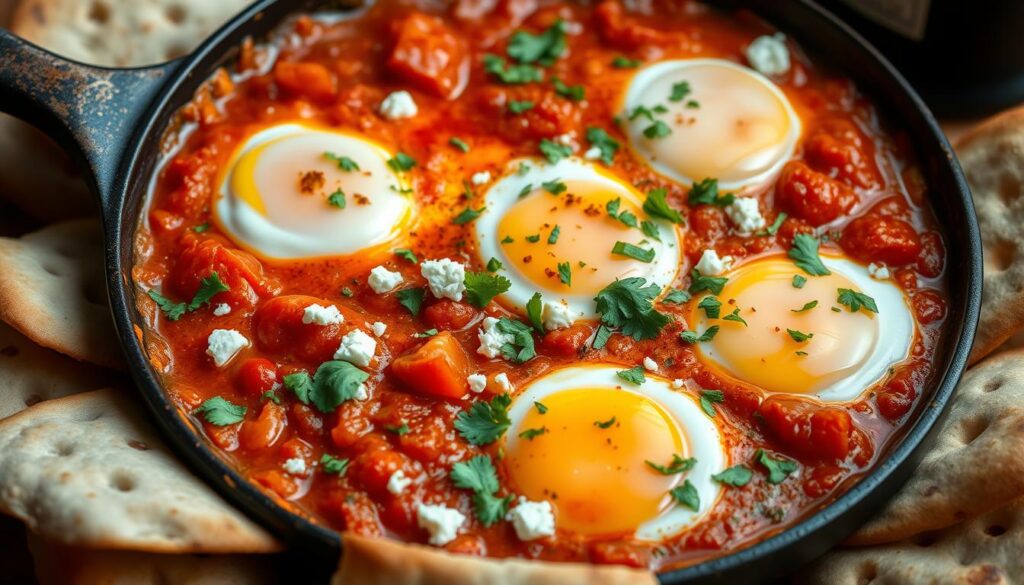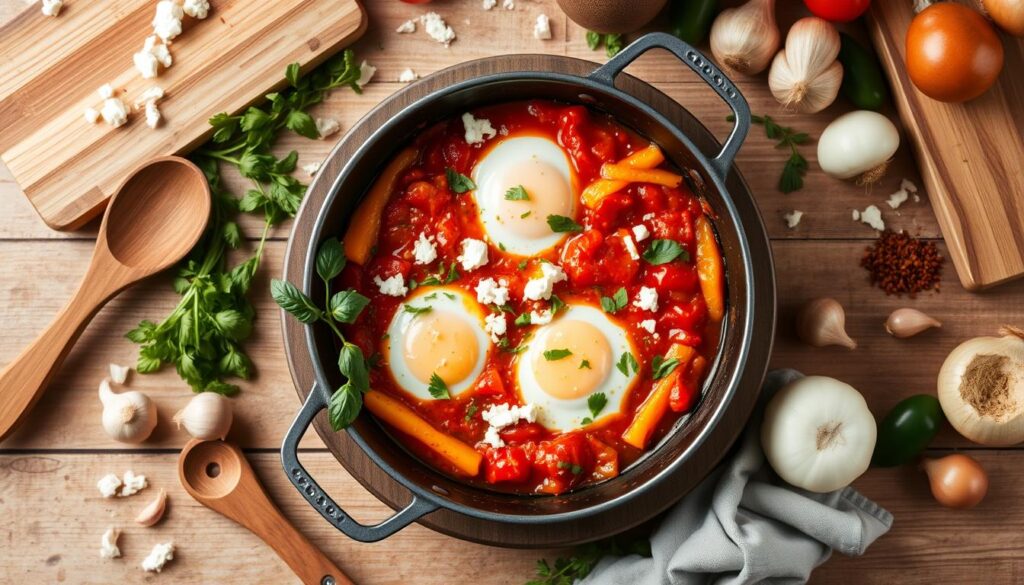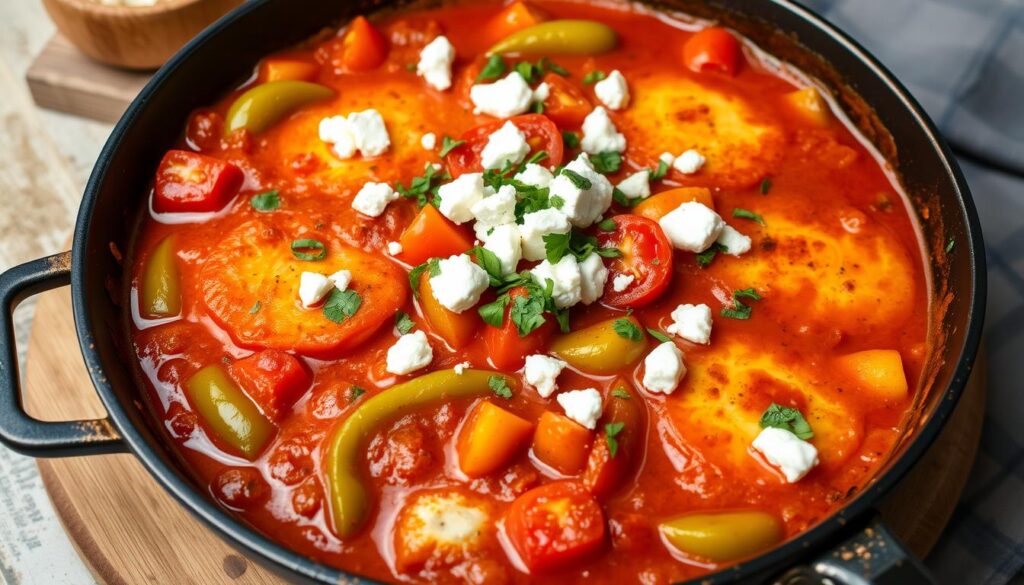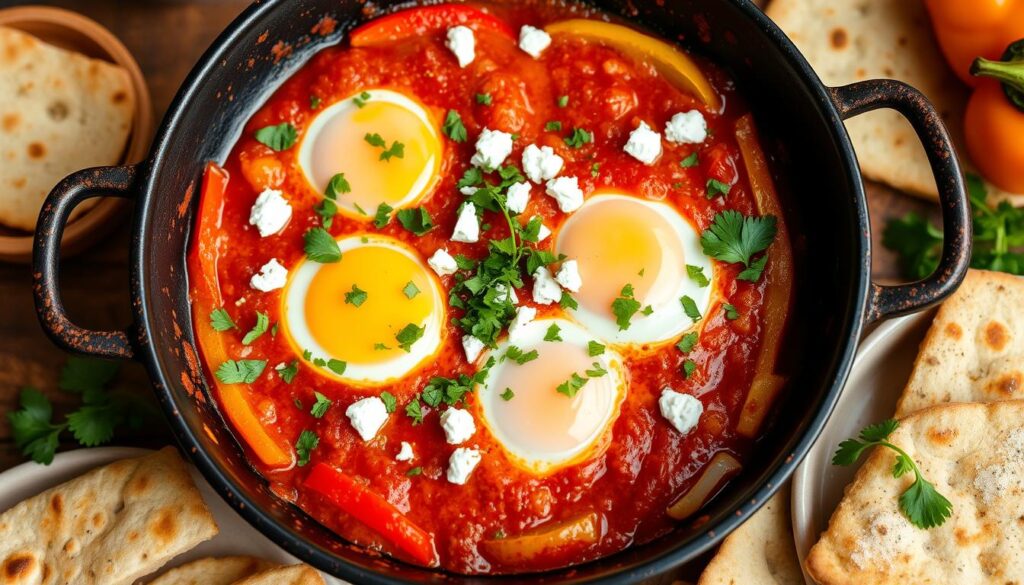Exploring Middle Eastern breakfast recipes, you’ll find shakshuka recipe. It’s loved in the US for its taste and ease. This dish, with its Middle Eastern roots, is now a favorite in many homes for a healthy start.
The recipe’s core is a simple cooking method. It mixes feta cheese with fresh herbs in a tomato sauce. It’s easy to make and you can make it your own. Whether you like it spicy or mild, you’ll love it.
Shakshuka with feta is all about simplicity and quality ingredients. You need fresh tomatoes, herbs, and feta cheese. These ingredients make a meal that’s both healthy and tasty. Let’s start this journey into the world of shakshuka with feta, a true gem in Middle Eastern breakfast recipes.
The Rich History of Shakshuka
Exploring Middle Eastern breakfast recipes often leads to shakshuka. This dish is loved worldwide and has a deep history. It comes from North Africa, where “shakshuka” means “to shake” or “to mix.”
Shakshuka started in North Africa, cooked in cast-iron pans over open flames. It was made with tomatoes, onions, and spices. It was served with bread or couscous. As people moved, they took shakshuka with them.
Origins in North Africa
In North Africa, shakshuka was a common breakfast. It was cooked in a tagine, a clay pot with a conical lid. This pot helped the flavors mix and ingredients cook slowly.
Migration to Middle Eastern Cuisine
Shakshuka changed when it reached the Middle East. New ingredients and spices were added. In Israel, it’s served with pita and hummus. In Egypt, it’s with ful medames, a fava bean dish.
Modern Global Popularity
Now, shakshuka is loved everywhere. It’s a favorite among food lovers and chefs. It’s great for breakfast or brunch, always a hit.
Essential Ingredients for Perfect Shakshuka with Feta and Herbs
To make a tasty Shakshuka with Feta and Herbs, you need fresh, quality ingredients. The right ingredients are key for a great dish. For an Easy shakshuka with feta, you’ll need eggs, feta cheese, and herbs like parsley, dill, and cilantro.
Herbs must be fresh for the best flavor in your Shakshuka. You can also try basil or oregano for a different taste. Choose a good feta cheese that’s not too salty. Here’s what you’ll need:
- Eggs
- Feta cheese
- Fresh herbs (parsley, dill, cilantro, etc.)
- Onions
- Garlic
- Bell peppers
- Tomatoes
- Salt and pepper
- Olive oil
The quality of your ingredients will affect your Shakshuka’s taste. So, pick the best you can find. Don’t be afraid to try new combinations for your perfect Easy shakshuka with feta.

With these ingredients and simple steps, you’ll make a delicious Shakshuka with Feta and Herbs. It’s perfect for any meal and will impress everyone. Whether it’s breakfast, lunch, or dinner, this dish will be a hit.
| Ingredient | Quantity |
|---|---|
| Eggs | 4-6 |
| Feta cheese | 1/2 cup |
| Fresh herbs | 1/4 cup |
Kitchen Equipment You’ll Need
To make a tasty shakshuka, you need the right kitchen tools. One-pan egg recipes are simple, so picking the right cookware is key. A large, oven-safe skillet is perfect for shakshuka. It spreads heat evenly and moves easily from stovetop to oven.
The cookware you choose matters a lot for one-pan egg recipes. Look for a skillet that’s strong, like cast iron or stainless steel. It should also have a handle that won’t get hot. This keeps your skillet safe at high temperatures and easy to handle.
Recommended Cookware
Here are some top picks for cookware:
- Cast iron skillets: They hold heat well and handle high temperatures great.
- Stainless steel skillets: They’re tough, don’t react with food, and clean up easily.
- Ceramic skillets: They offer a non-stick surface, but might not last as long as other materials.

Optional Tools and Accessories
There are extra tools and accessories that can make your one-pan egg recipes better. You might want a spatula, tongs, and an oven mitt. A spatula helps stir eggs and veggies gently. Tongs are handy for adding or removing ingredients. An oven mitt keeps your hands safe from burns when taking the skillet out of the oven.
Preparing Your Vegetables and Herbs
To make a tasty and healthy vegetarian breakfast, you need to prep your veggies and herbs right. Start by chopping them into the same size pieces. This ensures they cook evenly and brings out their natural flavors.
For chopping, use a sharp knife and a cutting board. Make sure all veggies are chopped to the same size. For a dish like shakshuka, focus on bell peppers, onions, and tomatoes.
Here are some key veggies and herbs for your shakshuka:
- Bell peppers: rich in vitamin C and antioxidants
- Onions: high in fiber and antioxidants
- Tomatoes: good source of vitamin C and lycopene
- Fresh parsley: rich in vitamin K and antioxidants
Adding these to your shakshuka boosts flavor and texture. It also makes your breakfast nutritious and
Keep your veggies and herbs fresh by handling and storing them right. With these tips, you’re ready to make a delicious and healthy shakshuka.
| Vegetable | Nutritional Benefit |
|---|---|
| Bell Peppers | Rich in vitamin C and antioxidants |
| Onions | High in fiber and antioxidants |
| Tomatoes | Good source of vitamin C and lycopene |
The Art of Creating the Perfect Tomato Base
The tomato base is key in a great Shakshuka recipe. You want a sauce that’s rich and flavorful, enhancing the eggs and other ingredients. Choose your tomatoes wisely. Fresh ones add a tangy taste, while canned tomatoes bring a deeper flavor.
Seasoning and spices are crucial in your tomato base. Onions, garlic, and bell peppers add depth and warmth. Don’t forget to try different spices like cumin, paprika, or chili flakes for a unique taste.

Selecting the Right Tomatoes
For Shakshuka, you can use fresh or canned tomatoes. Fresh tomatoes are best when in season, offering a vibrant flavor and texture. Canned tomatoes are convenient and consistent, perfect for a quick meal.
Seasoning and Spice Balance
To get the seasoning right, start by sautéing your aromatics in oil until they’re soft and fragrant. Then, add tomatoes, spices, and herbs. Let the sauce simmer until it thickens. Taste and adjust with salt, pepper, or spices as needed.
Achieving Ideal Consistency
The sauce should coat the eggs but still be pourable. Cook it for 20-30 minutes, stirring now and then, until it thickens. If it gets too thick, add a bit of water or tomato juice.
Adding and Cooking the Eggs
When making one-pan egg recipes, adding and cooking eggs is key. You need to make wells in the tomato sauce and crack eggs into them. Cooking the eggs over low-medium heat helps set the whites and keep the yolks runny.
Timing and temperature are crucial. Cook the eggs for 5-7 minutes, until the whites are set and the yolks are just right. Remember, keep the heat low-medium to avoid overcooking the eggs.
Here are some tips for cooking eggs perfectly in your one-pan egg recipes:
- Use fresh eggs for the best flavor and texture.
- Create wells in the sauce that are deep enough to hold the eggs.
- Cook the eggs over low-medium heat to prevent overcooking.
- Don’t overcrowd the pan, as this can cause the eggs to stick together.

By following these tips and techniques, you can make delicious one-pan egg recipes. They’re great for any meal. Whether you’re new to cooking or experienced, mastering the egg cooking technique is the secret to success.
| Egg Cooking Time | Doneness |
|---|---|
| 5 minutes | Runny yolks and set whites |
| 7 minutes | Set yolks and whites |
Incorporating Feta and Fresh Herbs
To make an easy shakshuka with feta, balance the flavors is key. Feta cheese is essential, and picking the right type matters. You can choose from Greek, Bulgarian, or French feta. Each has its own taste and texture, so try different ones to see what you like best.
For fresh herbs, you have many options. Parsley, cilantro, and dill are popular choices. They add a fresh taste to your shakshuka. You can use one or mix them for a unique flavor.
Choosing the Right Feta
When picking feta for your easy shakshuka with feta, consider these points:
- Origin: Greek feta is often seen as the most authentic, but others can be delicious too.
- Taste: Some feta is very salty, while others are milder.
- Texture: You can choose from crumbly, creamy, or a mix of both.
Complementary Herb Combinations
Here are some herb combinations that go well with easy shakshuka with feta:
- Parsley and dill: This classic mix adds a fresh, bright taste.
- Cilantro and parsley: This pairing balances warm and cool flavors well.

By choosing the right feta and herbs, you can make a tasty and easy shakshuka with feta. It will surely impress your family and friends.
Common Mistakes to Avoid
Preparing a Shakshuka recipe can be tricky. It’s easy to make mistakes that ruin the dish. Let’s look at common errors and how to avoid them. This way, you can make a delicious Shakshuka every time.
Getting the temperature, seasoning, and timing right is key. Temperature control issues can mess up your eggs. Seasoning errors can make the dish too salty or bland. Timing problems can also affect the taste and texture.
Temperature Control Issues
To avoid temperature problems, use a thermometer. It helps keep the skillet at the right heat. This ensures your eggs are cooked just right.
Seasoning Errors
Seasoning is crucial. Taste and adjust as you go. This way, you can avoid too much salt or not enough flavor. Remember, it’s easier to add more seasoning than it is to take it away.
Timing Problems
Timing is everything in Shakshuka. Cook your veggies and tomato base first. Then add the eggs and adjust the cooking time. Follow these tips for a balanced and delicious Shakshuka.
By avoiding these common mistakes, you’ll make a tasty Shakshuka. Happy cooking!
| Mistake | Solution |
|---|---|
| Temperature control issues | Use a thermometer to monitor heat |
| Seasoning errors | Taste and adjust seasoning as you go |
| Timing problems | Cook vegetables and tomato base before adding eggs |
Regional Variations and Modern Twists
Exploring Middle Eastern breakfast recipes, you’ll find shakshuka has many local flavors. From North Africa’s spicy harissa to the Middle East’s herb-filled versions, each place adds its own twist. This makes shakshuka a beloved breakfast dish worldwide.
Tunisian shakshuka is known for its spices, capers, and olives. Israeli shakshuka often includes feta cheese, parsley, and lemon juice. These variations show the Middle East’s diverse culinary traditions. They also inspire you to try new things with shakshuka.
Modern shakshuka recipes are full of possibilities. You could add jalapenos for heat or try goat cheese instead of feta. Using chorizo or merguez sausage can also add a new layer of flavor. The key is to mix flavors and textures in a way that’s both traditional and personal.
Here are some ideas for modern shakshuka:
- Roasting vegetables like eggplant or zucchini and adding them to the dish
- Using different breads, like pita or baguette, to scoop up the sauce and eggs
- Adding fresh herbs, like parsley or cilantro, to the sauce or as a garnish
By trying these regional and modern twists, you can create a unique shakshuka dish. It will show off the rich flavors and traditions of Middle Eastern breakfast recipes.
Serving Suggestions and Accompaniments
Serving shakshuka right can make your meal complete. It’s a great choice for a healthy breakfast or brunch. You can pair it with crusty bread or pita for a classic touch. These options bring out the dish’s rich and spicy flavors.
For something new, try adding modern side dishes. Here are a few ideas:
- Roasted vegetables, such as asparagus or Brussels sprouts
- A simple green salad with a light vinaigrette
- Grilled halloumi cheese or portobello mushrooms
These sides add freshness and variety. They make your meal a delightful experience you’ll want to repeat.
Traditional Pairings
In Middle Eastern and North African cultures, shakshuka is often paired with olives, artichoke hearts, or preserved lemons. These add a salty, tangy taste. Serving it with warm pita bread or couscous helps soak up the sauce.
Modern Side Dishes
There are also modern sides to try with shakshuka. Options include roasted sweet potatoes, quinoa salad, or grilled eggplant. These add freshness and variety, making your meal even more enjoyable.
Exploring different serving ideas can make shakshuka even better. Whether you go for traditional or modern sides, there’s a way to enhance its flavors and variety. Enjoy this delicious meal in many ways!
Conclusion
Shakshuka with feta and herbs is a true culinary delight that goes beyond cultural boundaries. It not only excites your taste buds but also brings people together. It’s perfect for any time of day, making it a favorite in many kitchens.
The charm of shakshuka with feta and herbs is in its simplicity and flexibility. Try different variations and add your own twist. This way, you’ll enjoy making a dish that’s good for both your body and soul. So, get ready to cook and explore the rich flavors of North Africa and the Middle East.
FAQ
What is shakshuka?
Shakshuka is a tasty Middle Eastern breakfast. It has poached eggs in a tomato and pepper sauce. It’s often topped with feta cheese and fresh herbs.
What are the main ingredients in shakshuka?
Shakshuka’s main ingredients are ripe tomatoes, bell peppers, onions, and garlic. It also includes eggs, feta cheese, and spices like cumin and paprika.
Is shakshuka a healthy breakfast option?
Yes, shakshuka is a healthy breakfast. It’s full of vitamins and minerals from the vegetables. The eggs add protein.
How do I properly prepare the vegetables for shakshuka?
Chop the onions, bell peppers, and garlic finely. This ensures even cooking and a good texture. Cutting them evenly is key.
What type of tomatoes are best for making the perfect shakshuka base?
Use ripe, juicy tomatoes for the best shakshuka. Fresh or canned diced tomatoes work well. Mixing fresh and canned tomatoes is also good.
How do I ensure the eggs are cooked perfectly in the shakshuka?
To cook eggs right, control the temperature and timing. Make wells in the sauce, crack eggs into them, and cover. Let them poach until the whites are set and yolks are runny.
Can I make substitutions or variations to the traditional shakshuka recipe?
Yes! Shakshuka is flexible. Try different cheeses like goat cheese or mozzarella. Experiment with herbs to find your favorite flavor.
What are some traditional and modern accompaniments for shakshuka?
Traditionally, serve shakshuka with crusty bread or pita. But, you can also pair it with roasted potatoes, a fresh salad, or avocado toast for a modern twist.
There are no reviews yet. Be the first one to write one.
Have you tried this recipe?

